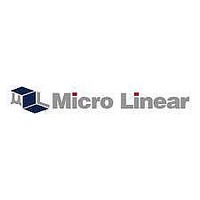ML4865ES-2 Micro Linear, ML4865ES-2 Datasheet - Page 7

ML4865ES-2
Manufacturer Part Number
ML4865ES-2
Description
High Voltage High Current Boost Regulator
Manufacturer
Micro Linear
Datasheet
1.ML4865ES-2.pdf
(10 pages)
DESIGN CONSIDERATIONS
INDUCTOR SELECTION
The ML4865 is able to operate over a wide range of
inductor values. A value of 22µH or 33µH is a good
choice, but any value between 15µH and 50µH is
acceptable. As the inductor value is changed the control
circuitry will automatically adjust to keep the inductor
current under control. Choosing an inductance value of
less than 15µH will reduce the component’s footprint, but
the efficiency and maximum output current may drop.
It is important to use an inductor that is rated to handle
1.5A peak currents without saturating. Also look for an
inductor with low winding resistance. A good rule of
thumb is to allow 5 to 10m of resistance for each µH of
inductance.
The final selection of the inductor will be based on trade-
offs between size, cost and efficiency. Inductor tolerance,
core and copper loss will vary with the type of inductor
selected and should be evaluated with a ML4865 under
worst case conditions to determine its suitability.
Several manufacturers supply standard inductance values
in surface mount packages:
OUTPUT CAPACITOR
The output capacitor filters the pulses of current from the
switching regulator. Since the switching frequency will
vary with inductance, the minimum output capacitance
required to reduce the output ripple to an acceptable
level will be a function of the inductor used. Therefore, to
maintain an output voltage with less than 100mV of ripple
(due to capacitance) at full load current, use the
following equation:
Coilcraft
Coiltronics
Dale
Sumida
(847) 639-6400
(561) 241-7876
(605) 665-9301
(847) 956-0666
V IN
47µF
C1
Figure 7. Typical Application Circuit.
(Continued)
SENSE
GND
V IN
V L1
ML4865
PWR GND
(Sumida CD75)
V OUT
SHDN
V L2
22µH
The output capacitor’s Equivalent Series Resistance (ESR)
and Equivalent Series Inductance (ESL), also contribute to
the ripple. Just after the NMOS transistor, Q1, turns off,
the current in the output capacitor ramps quickly to
between 0.5A and 1.5A. This fast change in current
through the capacitor’s ESL causes a high frequency (5ns)
spike to appear on the output. After the ESL spike settles,
the output still has a ripple component equal to the
inductor discharge current times the ESR. To minimize
these effects, choose an output capacitor with less than
10nH of ESL and 200m of ESR.
Suitable tantalum capacitors can be obtained from the
following vendors:
INPUT CAPACITOR
Due to the high input current drawn at startup and
possibly during operation, it is recommended to decouple
the input with a capacitor with a value of 22µF to 68µF.
This filtering prevents the input ripple from affecting the
ML4865 control circuitry, and also improves the
efficiency by reducing the I squared R losses during the
charge cycle of the inductor. Again, a low ESR capacitor
(such as tantalum) is recommended.
It is also recommended that low source impedance
batteries be used. Otherwise, the voltage drop across the
source impedance during high input current situations will
cause the ML4865 to fail to start-up or to operate
unreliably. In general, for two cell applications the source
impedance should be less than 200m , which means that
small alkaline cells should be avoided.
AVX
1M
Sprague
Kemet
R1
C
OUT
=
MBR0520L
10
V
D1
OUT
™
TPS Series
593D Series
T495 Series
L
(F)
V OUT
47µF
C2
(207) 282-5111
(207) 324-4140
(864) 963-6300
ML4865
(2)
7










